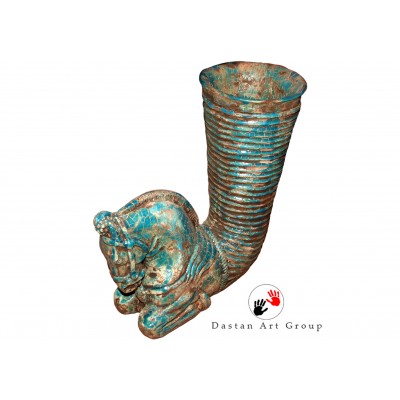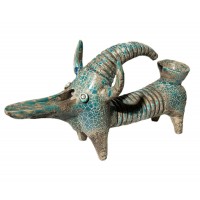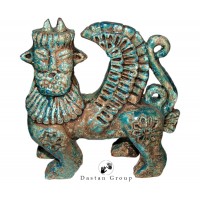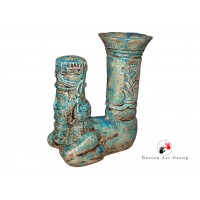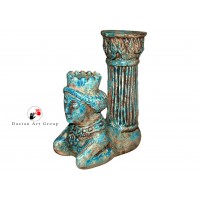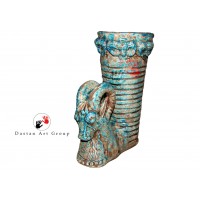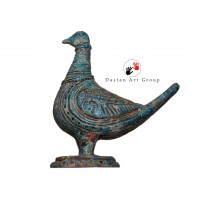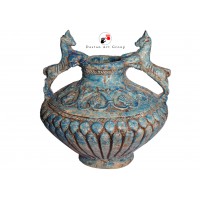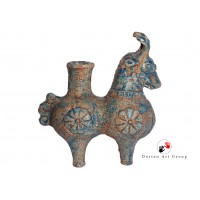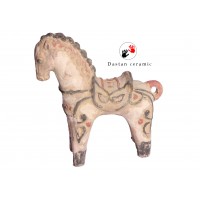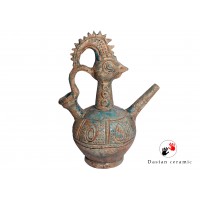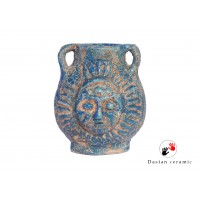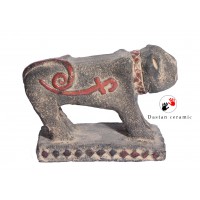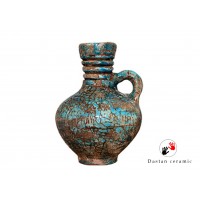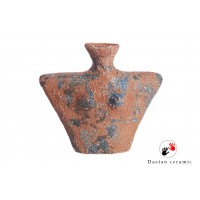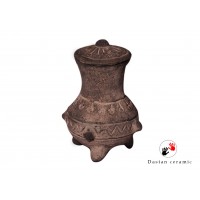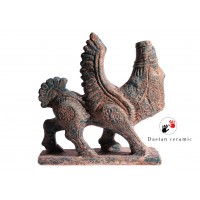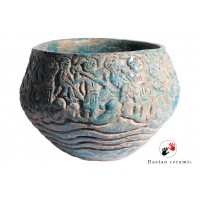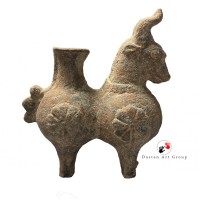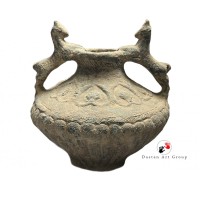The Golden Rhyton dates back to about 500 BC from the Achaemenid art masterpieces, rebuilt by the artistic group of hand made pottery in bake 850 degrees and turquoiseglaze in cooking 950 degrees
Liddell and Scott[2] give a standard derivation from Greek rhein, "to flow", which, according to Julius Pokorny,[3] is from Indo-European *sreu-, "flow". As rhutos is "stream", the neuter, rhuton, would be some sort of object associated with pouring, which is equivalent to English pourer. Many vessels considered rhytons featured a wide mouth at the top and a hole through a conical constriction at the bottom from which the fluid ran. The idea is that one scooped wine or water from a storage vessel or similar source, held it up, unstoppered the hole with one's thumb, and let the fluid run into the mouth (or onto the ground in libation) in the same way that wine is drunk from a wineskin today.
Smith points out[4] that this use is testified in classical paintings and accepts Athenaeus's etymology that it was named ἀπὸ τῆς ῥύσεως, "from the flowing".[5] Smith also categorized the name as having been a recent form (in classical times) of a vessel formerly called the keras, "horn", in the sense of a drinking horn.[6] The word rhyton is not present in what is known about Mycenaean Greek, the oldest form of Greek written in Linear B. However, the bull's head rhyton, of which many examples survive, is mentioned as ke-ra-a on tablet KN K 872,[7] an inventory of vessels at Knossos; it is shown with the bull ideogram (*227VAS; also known as rhyton). Ventris and Chadwick restored the word as the adjective *kera(h)a, with a Mycenaean intervocalic h.[8]
Rhyta shaped after bulls are filled through the large opening and emptied through the secondary, smaller one. This means that two hands are required: one to close the secondary opening and one to fill the rhyton. This has led some scholars to believe that rhytons were typically filled with the help of two people or with the help of a chain or a rope that would be passed through a handle. Rhytons modeled after animals were designed to make it look like the animal was drinking when the vessel was being filled.[citation needed] A bull rhyton weighed about three kilograms when empty and up to six kilograms when full.
Other rhytons with animal themes were modeled after boars, lions, and lionesses (such as Lion head horn). Some shapes, such as lioness rhyta, could be filled through simple submersion, thanks to the vessel's shape and buoyancy. Horizontally designed rhyta, like those modeled after lionesses, could be filled by being lowered into a fluid and supported. Vertically designed rhyta, like those modeled after boars, required another hand to cover the primary opening and to prevent the liquid from spilling as the vessel was filled.
Rhyta were often used to strain liquids such as wine, beer, and oil. Some rhyta were used in blood rituals and animal sacrifice. In these cases, the blood may have been thinned with wine. Some vessels were modeled after the animal with which they were intended to be used during ritual, but this was not always the case.[9]
| Specifications | |
| (Length Width Height (centimeter | 30*7*25 |
Related Products
lengthful marlik cow
.Marlik bulls attributed to the fourth millennium.Renovated pottery in bake 850 degrees and turquois..
2,264,000 Toman
marlik cow
The Marlik Hunter Cow attributed to the 4th Millennium in the Museum of Ancient IranPottery restruct..
2,556,000 Toman
Great bird ewer
.ewer pottery made of Kashan with the role of a bird and a flower decorated with lagoon monochrome g..
1,816,000 Toman
ozhan
Eugene is an inveterate enemyInspired by the Lorestan bronze spells of the 7th and 8th centuries BCP..
1,964,000 Toman
Achaemenid man rhyton
Inspired by the head of the palace of the three gates of Persepolis, reconstructed by the artistic g..
1,964,000 Toman
Prince rhyton
Inspired by the sculpture of one of the princes of the Achaemenid woman, restored by the Dastan art ..
1,964,000 Toman
Golden grail rhyton
Inspired by the golden Achaemenid glass, in the fifth and fourth centuries BC, this work is held in ..
2,200,000 Toman
Pigeon
The bird of Iranian science decorations held at Istanbul's Topkapi Museum is an example of the symbo..
2,358,000 Toman
Goaty knob Jug
A jar shape dish with handles looking like mountain goatIt is of Ashouri or Ourarti styleIt believed..
5,678,000 Toman
ministers
Humpback bull inspired from historical erthenwaremade manually from gray clay..
3,014,000 Toman
rhyton Princess
Inspired by the sculpture of one of the princes of the Achaemenid woman, restored by the Dastan art ..
3,929,000 Toman
rhyton Achaemenid Man
Inspired by the head of the palace of the three gates of Persepolis, reconstructed by the artistic g..
3,929,000 Toman
bird
The bird of Iranian science decorations held at Istanbul's Topkapi Museum is an example of the symbo..
4,716,000 Toman
Marlik cow
The Marlik Hunter Cow attributed to the 4th Millennium in the Museum of Ancient IranPottery restruct..
5,113,000 Toman
Marlich cow stretched
.Marlik bulls attributed to the fourth millennium.Renovated pottery in bake 850 degrees and turquois..
4,528,000 Toman
ministers
Humpback bull inspired from historical erthenwaremade manually from gray clay..
6,028,000 Toman
Goaty knob Jug sediment
A jar shape dish with handles looking like mountain goatIt is of Ashouri or Ourarti styleIt believed..
11,356,000 Toman

